A type of pottery called Flow Blue is patterned on the well-known porcelain. It can be identified by the intricate designs that are simultaneously blurred in their image and coated with cobalt oxide.
This was not intentionally done, but instead was the result of a manufacturing error that gained popularity during the Victorian era and is still a highly in demand collectible today.
Flow Blue antique china is widely valued by collectors all over the world for its magnificent, flowing blue hues and exquisite patterns. There are many different patterns available for this vintage flow blue china, some of which are very expensive.
The elaborate and exquisite design of flow blue china draws attention to any spot where it is showcased. It had to be worth a significant sum of money, right?
Have you thought of starting a china collection but are unsure where to begin? Let’s talk about the value and identification of flow blue china in this article.
Table of Contents
What Flow Blue Actually Is?
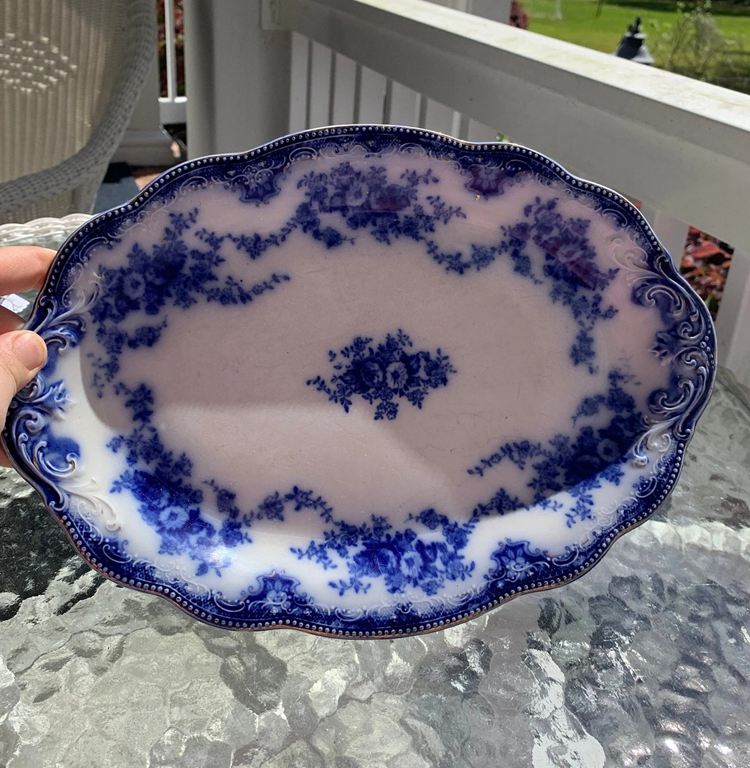
A rare piece of antique blue-and-white porcelain is called Flow Blue. In the past 45 years, there have been multiple booms in interest in historic dishware, which was most renowned during the Victorian era.
Transferware, a category of vintage china, includes Flow Blue. The design that was initially flawed now has a soft, hazy look thanks to the manufacture of this lovely dishware. The gorgeous cobalt blue color of the ornamentation contrasts with the sparkling white background.
Production and Invention of Flow Blue
Chinese stoneware was a highly sought-after item in England during the late 18th century. Only the rich can afford the deeply blue hand-painted designs on stark white backgrounds because they were so pricey.
The salt-glazed ceramics that produced the stark white base and the coating of cobalt oxide that gave the Oriental blue designs such attraction had to be recreated by English potters, which took more than a century.
English potters invented the transferware method for impressing a pattern on china in the late 17th century:
- Heat is applied after a design is carved on a copper plate.
- The copper plate with the engraving receives a coat of cobalt oxide.
- The perforated copper plate is then covered with damp tissue paper.
- The tissue is then attached to the pottery after it has been removed from the copper plate.
- Tissue papers floating in water are signs that ceramic pieces have been submerged in water.
The precise genesis of Flow Blue is a subject of significant debate. Some studies claim that the cobalt oxide accidently flowed somewhat past the boundaries of the artwork because the coloring component unintentionally scattered. According to other sources, the diffusion was purposefully applied to smooth down the pattern’s sharp angles. It may have started off as an accident, but the result was so alluring that it spread quickly.
Historical Evolution of Flow Blue patterns
Certain historical evolution phases of flow blue china are worth more than others. You may also determine the period of time it was manufactured by looking at the pattern. Collectors focus on the following three main periods of flow blue china:
Early Victorian Flow Blue – 1830 to 1860
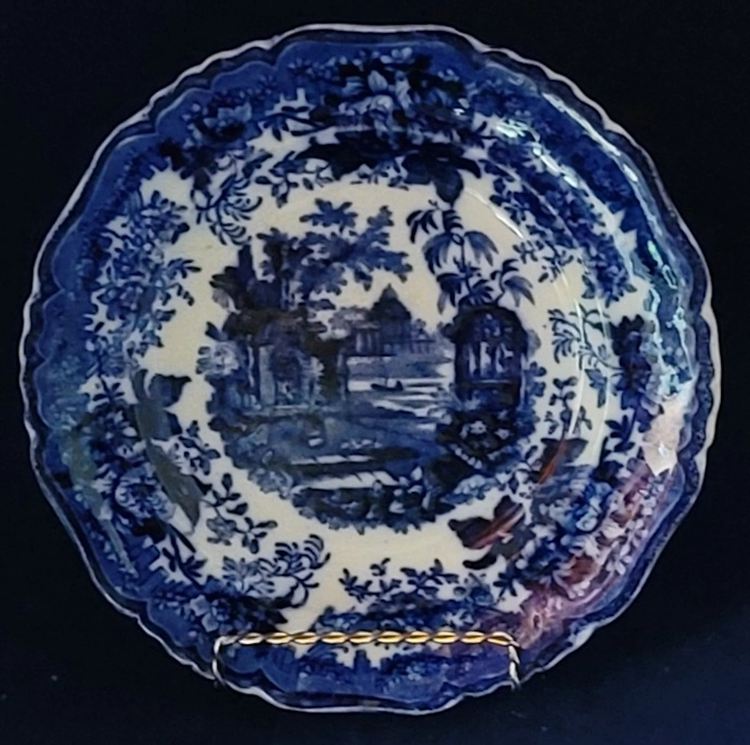
Ironstone in vivid blue color with designs that typically covered the full piece was used in early Victorian Flow Blue (1830–1860). These patterns closely resembled the Oriental textiles from Canton and Nanking that were imported.
Here are some of the early Victorian design patterns:
No. |
Name |
Image |
Year |
Description |
1 |
John & George Alcock Scinde pattern |
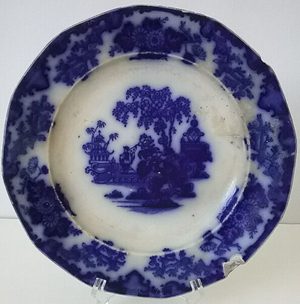 |
1840 |
This 1840 design, which takes its cues from the Blue Willow, includes an elegant temples, willow tree, and florals. |
2 |
Edward Challinor Rock |
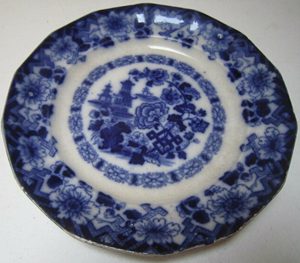 |
1845 |
This Oriental pattern dates back to 1845 and has geometric patterns, willows as well as floral patterns. |
3 |
Podmore & Walker Manilla pattern |
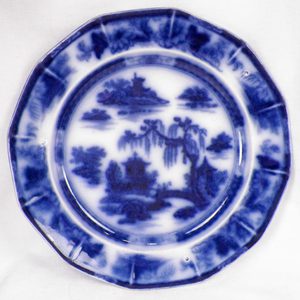 |
1845 |
Palm trees and willows are arranged in a dreamy Oriental design in this pattern from around 1845. |
4 |
Thomas Fell Excelsior |
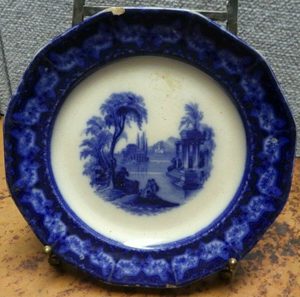 |
1850 |
This 1850 design features a pavilion, a waterway or canal, and trees. |
Mid Victorian – 1860 to 1885
The Flow Blue patterns of the Mid Victorian period (1860–1885) were more intricate, less geometric, and curved than earlier designs. The dishes and associated items occasionally had gold trim and frequently featured floral or naturalistic landscapes.
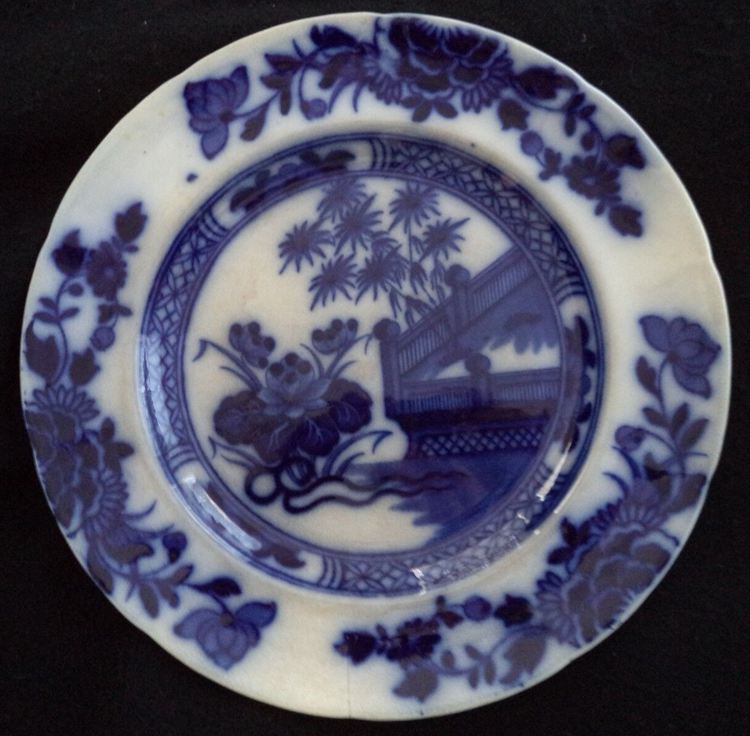
Here are some of the Mid Victorian design patterns:
No. |
Name |
Image |
Year |
Description |
1 |
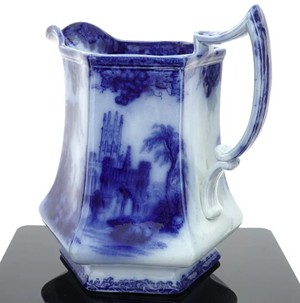 |
1860s |
This 1860s pattern features a Gothic temple with trees. |
|
2 |
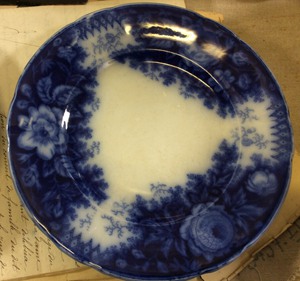 |
1870 |
This lovely floral design, which dates to around 1870, has delicate flowers and leaves. |
|
3 |
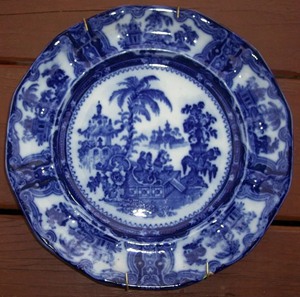 |
1870 |
This design is from the 1870s and displays an extremely detailed traditional Oriental-inspired landscape. |
|
4 |
William A. Adderley Constance |
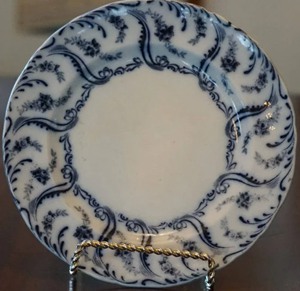 |
1875 |
This straightforward design, which dates to around 1875, omits the finer details in favor of lovely blossoms on the rim. |
Late Victorian Flow Blue – 1885 to 1920
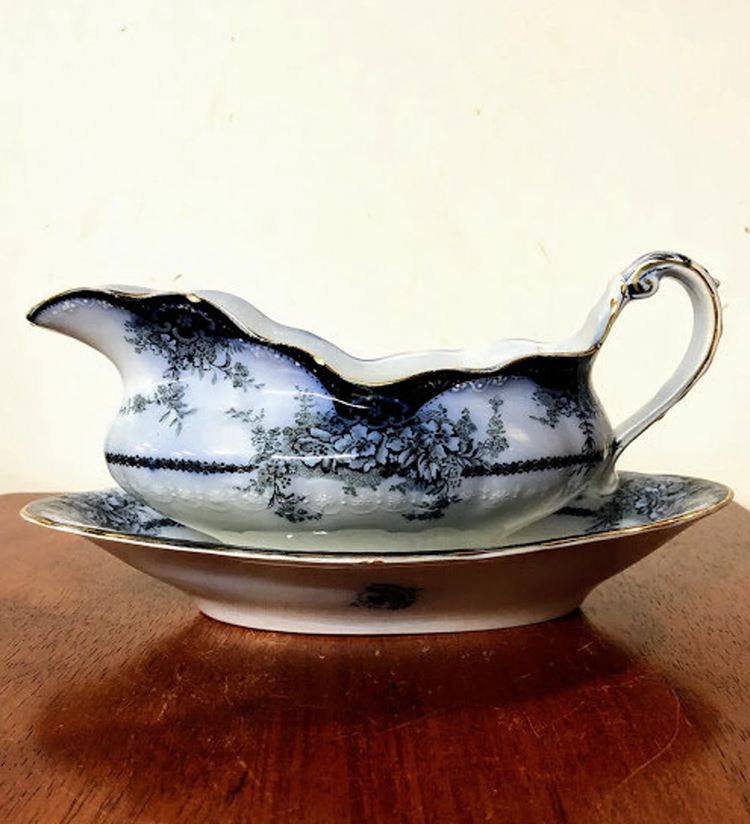
The use of “semi-porcelain” instead of heavier ironstone is a highly distinct design difference in late Victorian Flow Blue (1885–1920). The design covered a much smaller portion of the surface, and the rim may have been enhanced with beading or embossing. Natural and, a bit later in the era, Art Nouveau floral motifs with their stylized blossoms and curves remained the most prevalent.
Here are some of the Late Victorian Flow Blue design patterns:
No. |
Name |
Image |
Year |
Description |
1 |
Alfred Meakin Kelvin pattern |
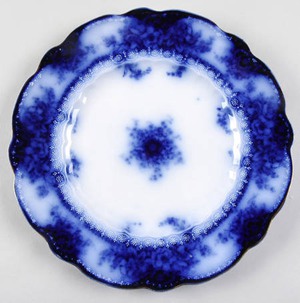 |
1891 |
Pattern by Alfred Meakin Kelvin, created in 1891, with delicate floral motifs and subtle gold accents. |
2 |
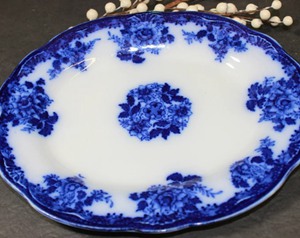 |
1892 |
This 1892 pattern features gorgeous blooms in the middle and close to the rims. |
|
3 |
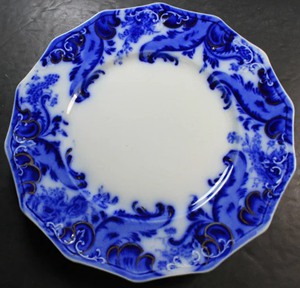 |
1896 |
This well-known pattern from 1896 is a classic with its flowing paisley design. |
|
4 |
Wheeling Pottery of West Virginia La Belle pattern |
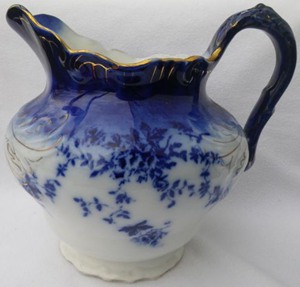 |
1900 |
This lovely pattern, which dates to 1900, has hand-painted floral accents. |
Flow Blue: The Four Basic Designs
Romantic Design
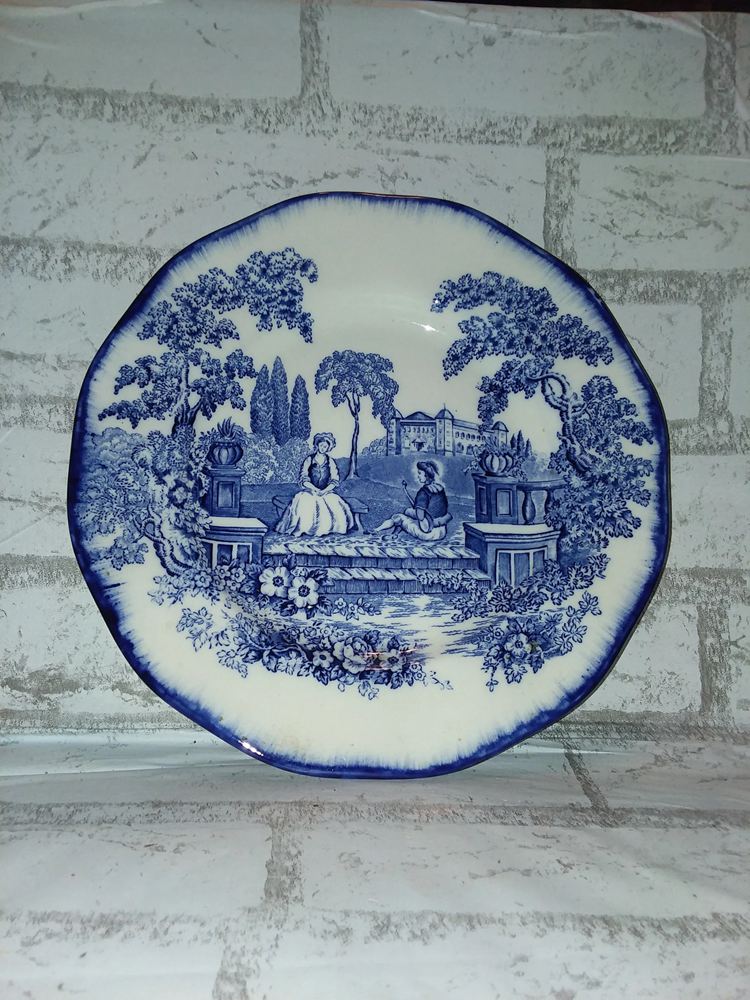
Romanticism, which was prevalent throughout the Victorian era, had an impact on the early popularity of Touraine Flow blue. As a result, this style contains numerous patterns of pastoral landscapes. Between the rococo and neoclassical eras, pastoral art develops as a result of the prevalence of joy and celebration of life in everyday circumstances. The aim of this approach was to make place for humor, grace, and light sexuality while having little concern for the state, let alone the church.
Romantic patterns include collages, wonderful city landscapes, and scenic themes with animals and foliage. The Flow Blue romance designs that are most valuable are:
Oriental Designs
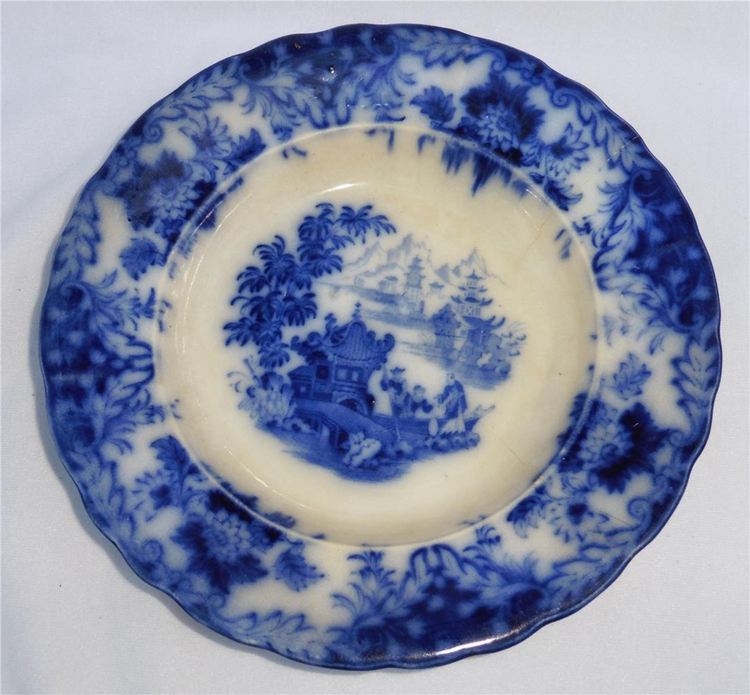
Buddhist temples and shrines, Asian countryside such as hillsides and orchards, and people dressed in Chinese clothing may all be depicted with Oriental patterns in Asian-inspired patterns. It used to be that westerners considered oriental cultures all cultures located east or southeast of Europe to be oriental cultures. A typical Oriental pattern may include themes from the Middle East, Japan, and India.
Oriental-inspired collectible designs that are in high demand are:
Floral Designs
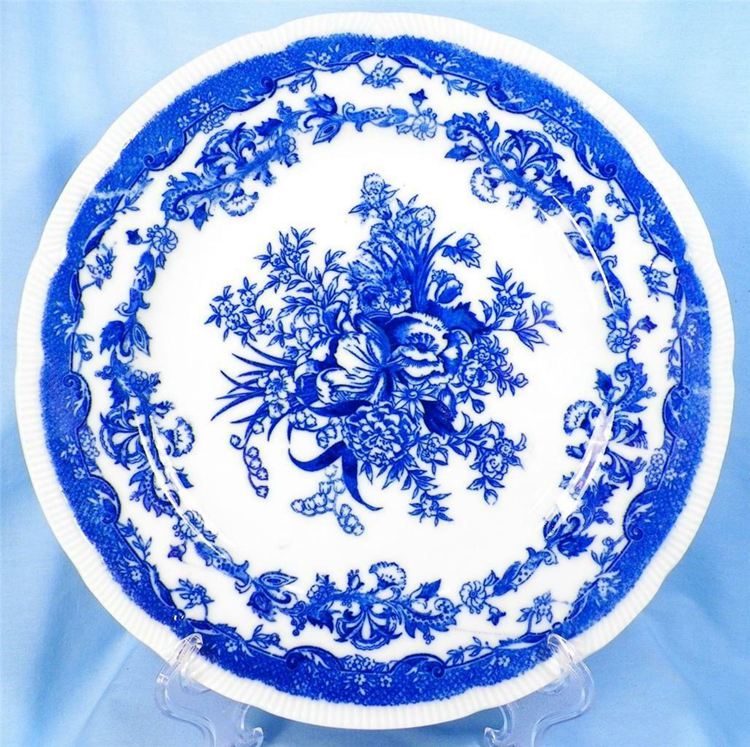
Throughout history, floral designs have been prominent on everything from early ironstone to porcelain, but at the time that flow blue became popular, flower arrangements were the main focus of many other types of artwork. It was a time of colonization across all of Europe, which explains this.
Holland, Spain, France, England, Germany, and Portugal all had a presence in other parts of the world, such as Africa and America, where they found numerous new plant and flower species.
As a result, flower arrangements in art became more widely appreciated and were available in a variety of styles. Their influence even spread to flow blue, where we can see beautiful floral patterns.
The most valuable floral collectibles that are most in demand include:
- Seville by Wood and Sons (1900)
- Argyle by W.H. Grindley (1898)
- Blue Danube (1900 -1904) by Johnston Brothers
- La Belle by Wheeling Pottery of West Virginia (1900)
- Lonsdale Ridgeways (1910)
Brush Stroke Design
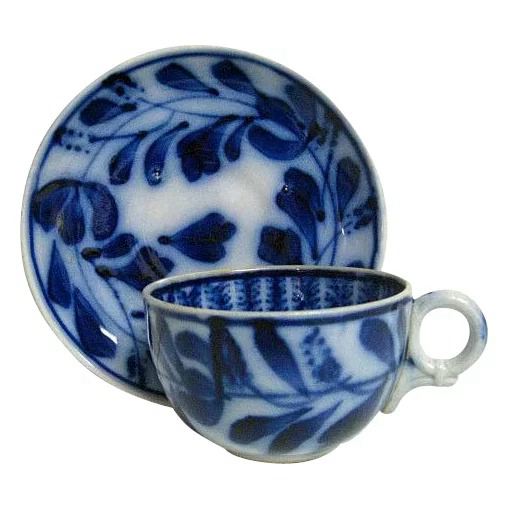
Another variety of Flow Blue is brush-stroke, which features hand-painted brush strokes. Other hues besides white and blue may be present, and it has a pink or copper gloss.
- Tulip and Sprig by Thomas Walker (1845)
- Aster and Grapeshot by Joseph Clementson in Canada (1840)
- Blue Bell (1845–1850)
- Strawberry by Thomas Walker (1856)
- Spinach or Hops Petrius Regout
How to Value Flow Blue China?
Variety and price are two of the things to consider when shopping on the Flow Blue marketplace. If you wish to employ artwork in your house, you shouldn’t host Supper on china flow blue that cost $100 each but possess no inherent worth.
The demand, the strength of the market, the uniqueness, and the quality of Flow Blue antiques are just a few of the numerous variables that affect price. Because they are more common there, some patterns are more common there than in other places.
Flow Blue’s Value-Increasing Factors
- Condition – Without fractures or cracks is the best condition that makes Flow Blue valuable.
- Rarity– Since rarity increases value, it stands to reason that some pieces have become more valuable as a result of breakage. Since lids, spouts, and handles are more prone to breaking when being moved or used, items with intact ones will be worth more.
- Types of piece– There are more of particular products available since they were manufactured at a faster rate. There will be dozens of saucers, cups, bowls, and plates for each teapot, creamer, or sugar bowl that is still present, hence these different types of Antique Flow Blue add much value to your vintage Flow Blue China Products.
Price Guide for Flow Blue
It is crucial to understand the worth of flow blue china if you’re thinking about purchasing or selling some. Because this china was so well-liked for such a long time, there are many of examples available on the antiques market. Because of this, it is a reasonable antique to collect. Affordable pieces start at roughly $10, although others are significantly more expensive. Condition is crucial for antique dish values as with all antiques as mentioned earlier. You should spend money on a professional appraisal if you believe you may possess a valuable item.
Identification of Flow Blue
The bottom of better dishes is stamped with the manufacturer’s name. Examine the maker’s stamp closely and make as many notes as you can. Use a magnifier if the vision is hazy.
- You can find materials that will help you identify the type of blue you own or suggest patterns you might be interested in in the future. Due to the age of many of the publications and the time when they were printed, the values presented will not reflect current prices. It is possible, however, to figure out what you have with their help. You may find the following books helpful:
- Antique Flow Blue China Collectors ID & Price Guide by Jeffrey Snyder
- Flow Blue: A Collector’s Guide to Patterns, History, And Values
- Gaston’s flow blue china: comprehensive guide, identification and values
- Collectors Encyclopedia of Flow Blue China
An antique sale featuring Flow Blue
If you are an Antique Flow Blue lover or wants to go for collectibles, we can help you in finding out the right place where you can purchase your desirable piece. Here are is the list of few items that are on sale now.
Flow Blue Collectibles |
Price |
Where to find online |
Condition |
Antique Mark Flow Blue & Gold Plate or Shallow Bowl Berries 11″ Diameter |
$45.00 |
Very good condition – No chips, nicks, cracks, crazing. |
|
Antique Burgess & Leigh Flow Blue VERMONT Pitcher |
$25.00 |
Excellent |
|
Antique Alfred Meakin Ltd Flow Blue DEVON Plate ENGLAND |
$29.99 |
No chips, no cracks |
|
Flow Blue “India” Plate |
$79 |
Good condition |
|
Watteau Burslem Royal Doulton Small Plate England Flow Blue Figural |
$55 |
Great condition – no chips and cracks |
|
J & G Meakin Flow Blue Gravy Boat-Colonial |
$65 |
Excellent |
|
Antique Flow Blue Platter Ridgways |
$150.23 |
etsy |
Good condition |
Antique W.H. GRINDLEY “Melbourne Flow Blue” Design – Gravy Boat |
$55.00 |
Excellent condition |
|
Victoria Ware Ironstone, Flow Blue Creamer , England |
$21.88 |
Good used condition, without damage |
How to value Flow Blue by Yourself?
Here are the few steps which helps you in identification of Flow Blue by yourself. Here we go:
Identify the stamp
Look for the stamp on the Flow Blue China’s base. Use a maker’s mark catalog (ask your library for one) or a reverse internet search to identify it. This will instantly screen out any china that is worthless since it was produced by a mysterious or fake company.
Keep an eye out for the pattern
If there isn’t a pattern number, this will enable you to locate the pattern in the manufacturer’s catalogue. It’s yet another chance to discover a fake product. Like a game of “spot the difference,”
Discover auction prices
For your china items, check out auction websites (and perhaps eBay). Finding a price for your item is simple with this method. It can be extremely rare if you can’t discover your porcelain online or on any auction site.
Verify with seller
You may frequently purchase replacements for large dining sets online. You can order a replacement saucer from the original maker or from a replica firm if you only have two saucers and three teacups. This could be a sign of rarity if neither is currently reproducing that design or style.
Get a professional to appraise your fine china if you haven’t yet discovered a price on an auction website and believe it may be extremely rare.
Utilizing unreliable online antiques specialists is one possibility. Upload pictures of your china to Reddit, eBay, Amazon. etsy or another antiques community. If it doesn’t work, you should look for a reputable antiques dealer.
Cleaning and caring for Flow Blue China
Never put these vintage flow blue china pieces in the dishwasher because they were made long before dishwashers were ever a notion.
Warm water and a mild dish soap should be used to hand wash all Flow Blue collectibles. Let dry naturally or delicately hand-dry with a towel. The Antique Flow Blue is typically quite dainty and delicate, so must take care of them while cleaning.
Where to Buy Antique Flow Blue?
Searching online is your best option if you need to find one immediately. Consider the following sites:
- e-Bay– The Flow Blue pottery of your dreams can be easily found on eBay, one of the greatest sites to find beautiful pieces of vintage furniture. It’s also ideal if you’re considering selling because they provide a very user-friendly e-commerce feature and can reach a sizable global audience.
- Ruby Lane– Since their auction stream is sourced via more conventional methods, Ruby Lane is, it must be said, a little more constrained in the number of Flow blue antiques that are offered at once. It’s a good idea to constantly checking their inventory, though, as they are one of the biggest online auction houses, to see if they have what you’re searching for posted.
- Etsy– Since people frequently discover these Antique Flow Blue in their grandparents’ homes across the nation, internet marketplaces like Etsy are among the greatest places to find a ton of these pieces on sale.
Some Quicks Facts to know about Flow Blue
- The majority of flow blue patterns are transferware, which means that instead of being manually painted, the patterns were applied using a paper stencil.
- The blue glaze that spilled during burning, giving the pieces a blurred appearance, gave flow blue china its name.
- Although flow blue china comes in a variety of blue tones, vivid cobalt blue is the color that collectors most value.
Frequently asked Questions
How do you identify the Flow Blue?
But it’s distinct from traditional Blue Willow and other angular transferware designs. Flow Blue is the name of a white and blue china pattern. The blue design is intentionally foggy because lime was added to the kiln when the piece was being burned.
Why it’s called Flow Blue?
The white earthenware and porcelain design known as “flow blue” was developed by Staffordshire potters in England during the Regency era, around the 1820s. The blue glaze’s “flooding” or blurring during firing gave rise to the name of the object.
Lead is there in flow blue?
In or around 1825, Staffordshire, England, produced the first batch of Flowing Blue. While cobalt blue underglaze could resist the heat of the kilns, several glazes incorporating lead oxide gave flow blue wares their distinctive depth of color and sparkle.
Does Flow Blue China have any value?
Flow Blue’s price ranges from $35 to $500, based on the product’s antiquity, condition, style, age, and market demand. Certain ancient objects may be valuable or exhibit-quality.
Our Takeaway!
We really hope that this article seems useful to you. We can assist you if you have flow Blue and want to sell it or if you want to buy one of these collection items.
You now have a greater grasp of its background, value, identification process, and the countries where it is most common.
Keep in mind that the value of your Antique Flow Blue will only rise with time; as a result, we sincerely hope you will heed our advice and safeguard your items by keeping them spotless and glittering as if time had not passed.

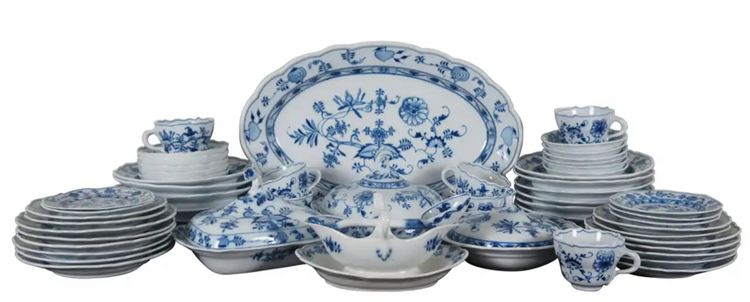
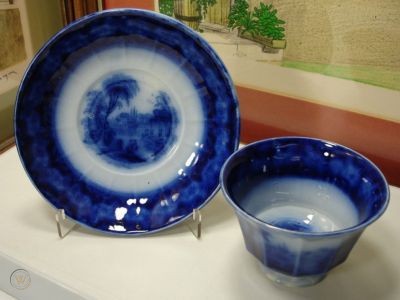
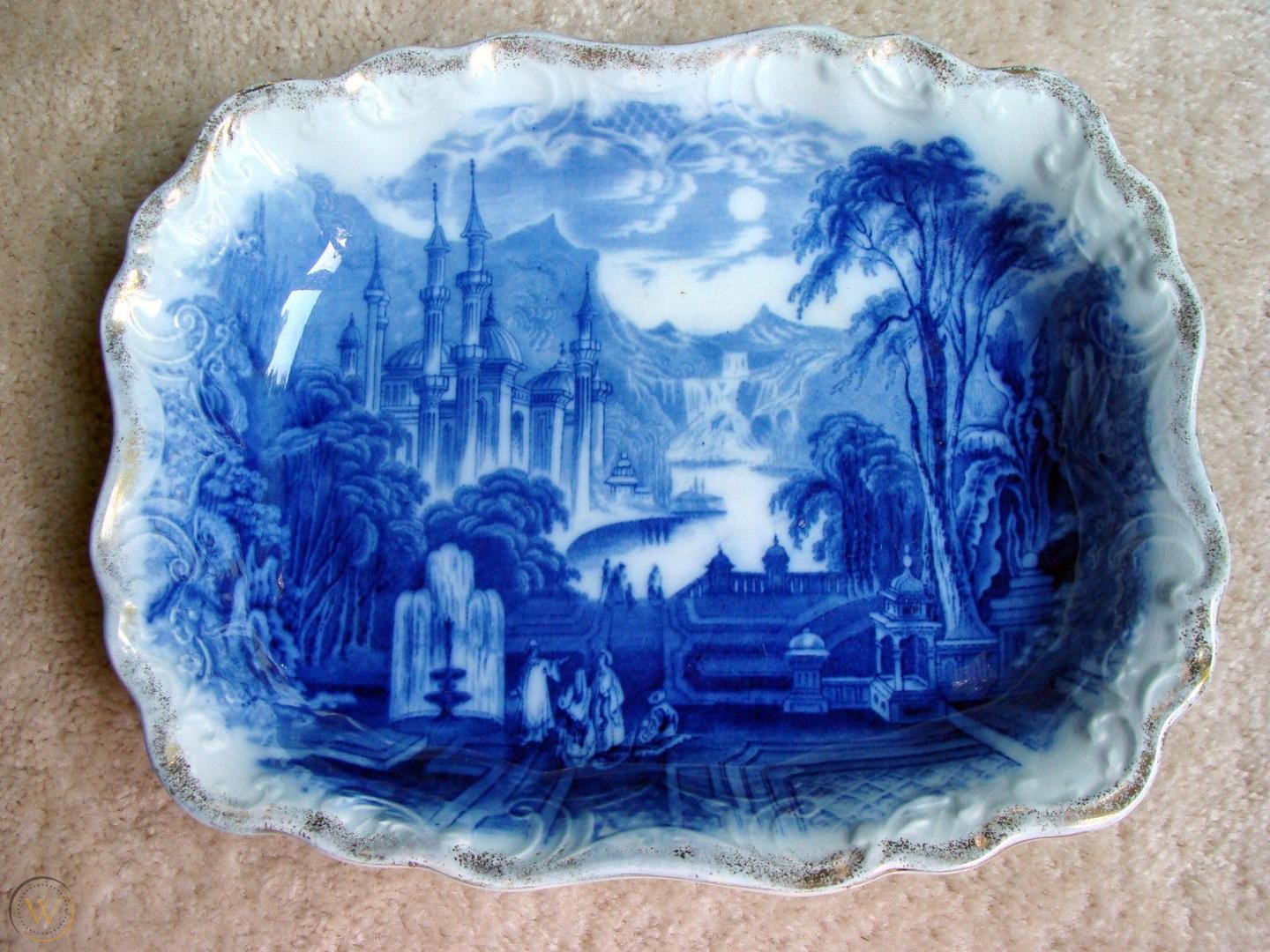
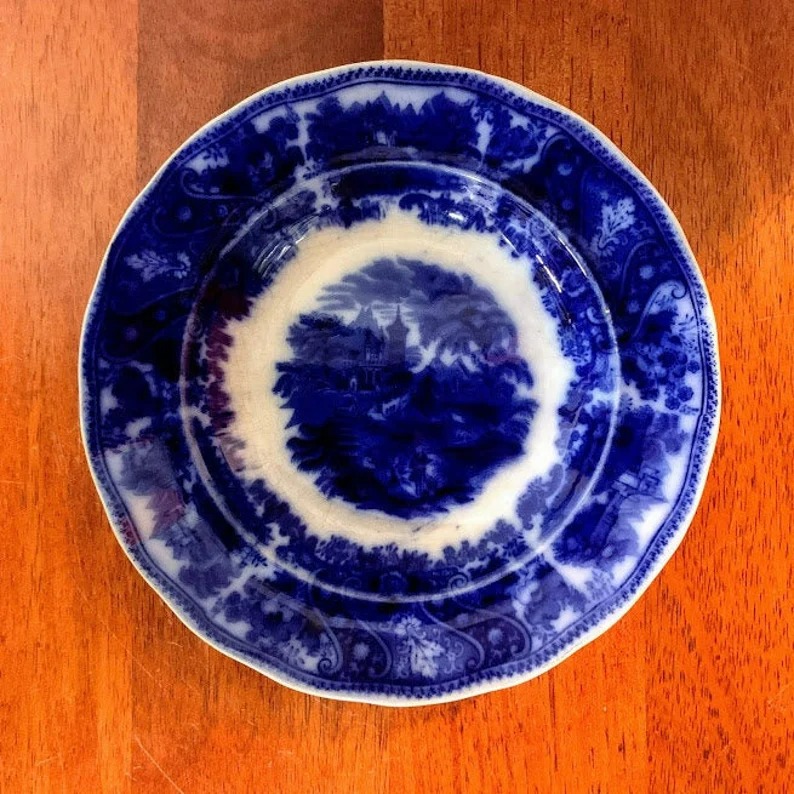
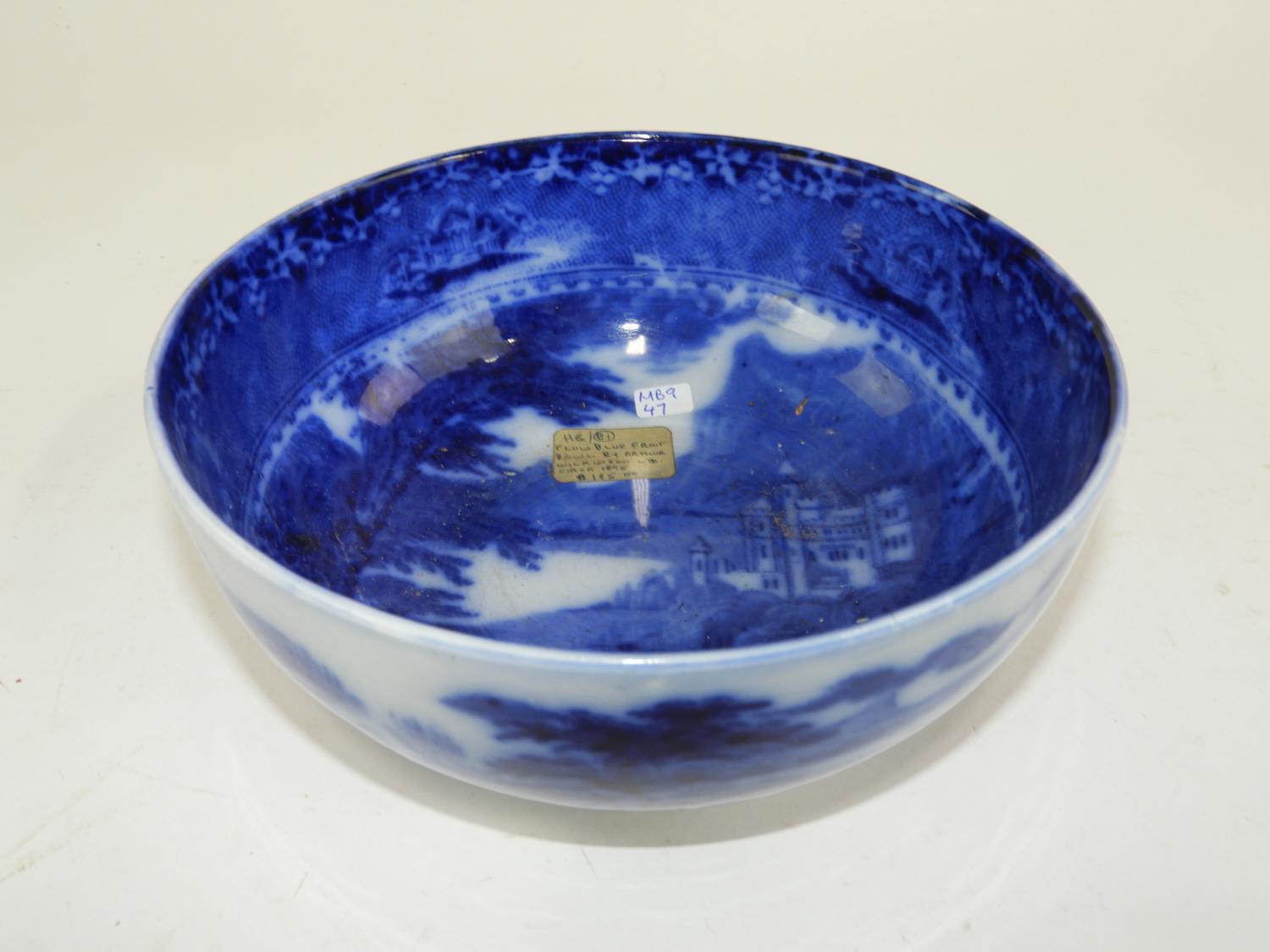
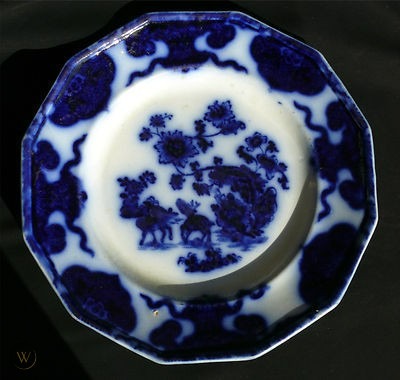
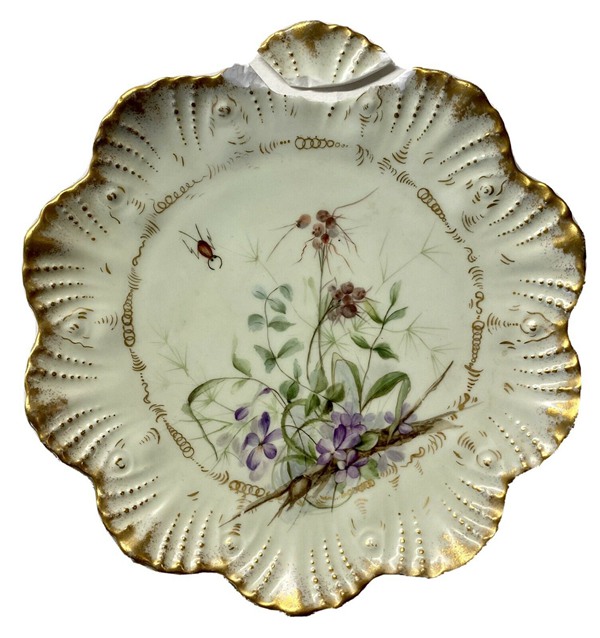
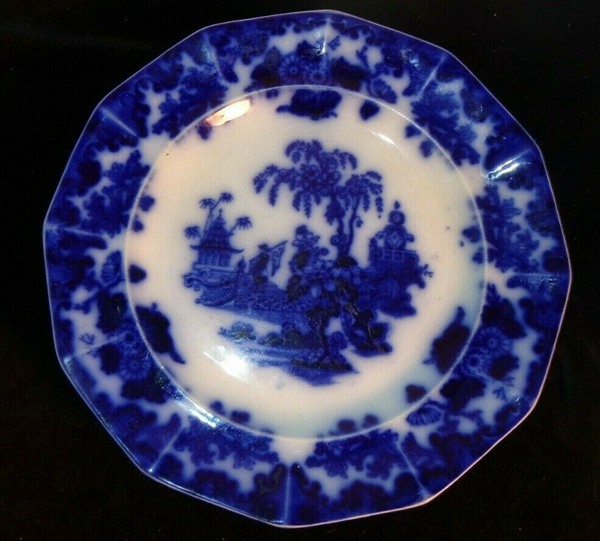
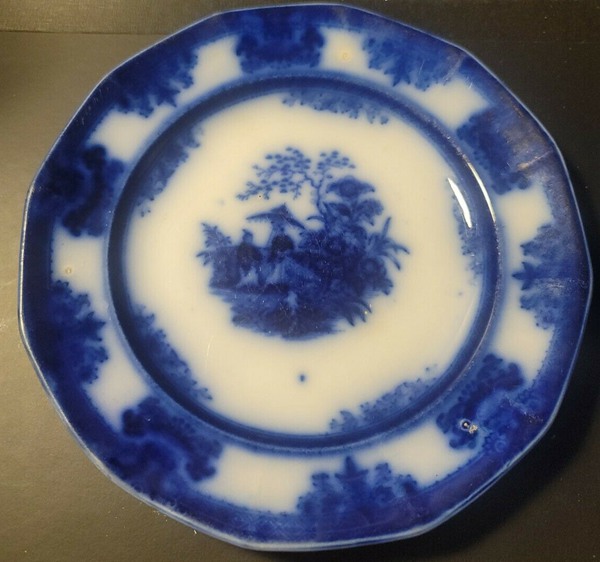




![Where To Sell Antique Furniture In 2022 [Ultimate Guide]](https://www.jacquelinestallone.com/wp-content/uploads/2022/09/Etsy-Your-Place-To-Buy-And-Sell-All-Things-Handmade-600x450.jpg)


